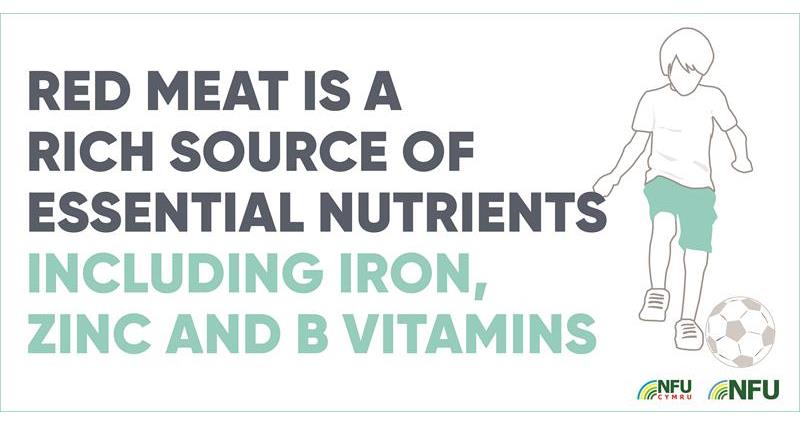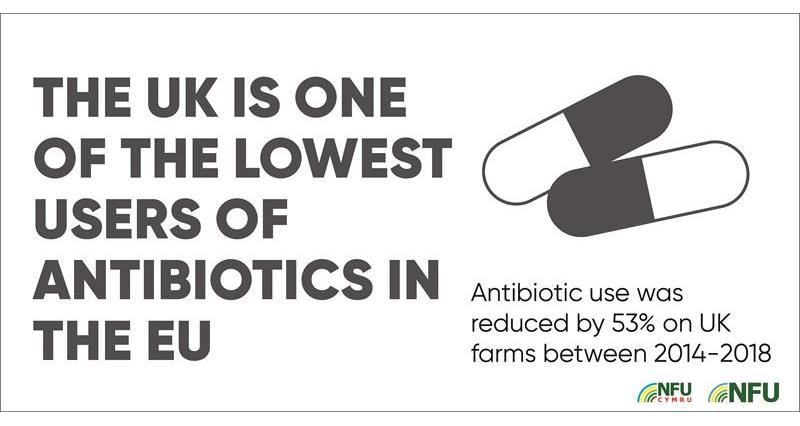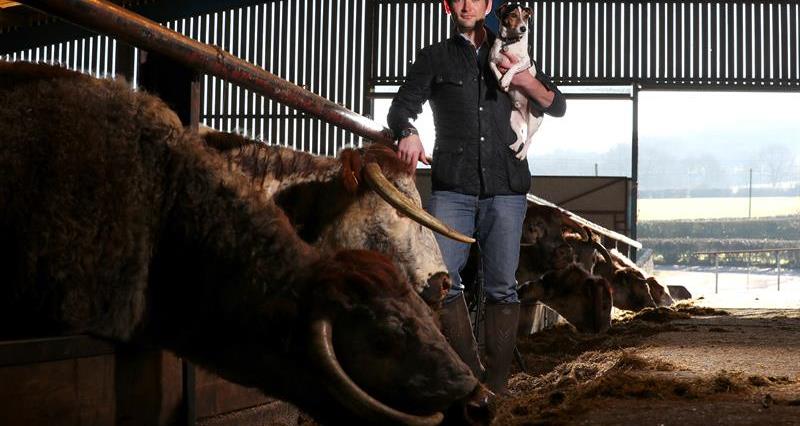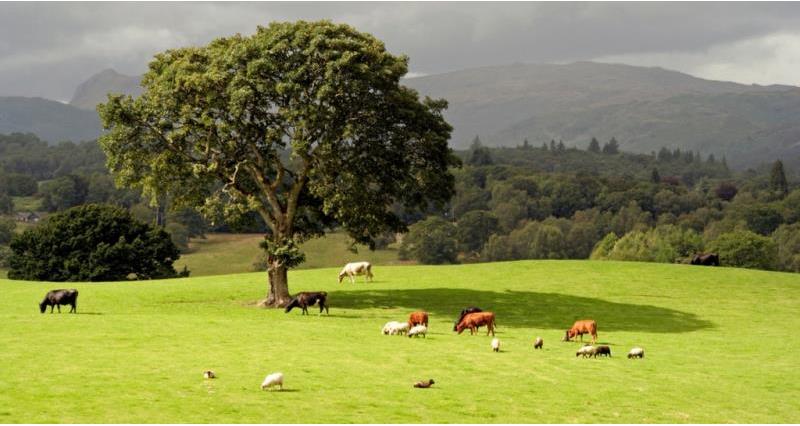Livestock, climate change and the environment
British farmers are leading the way in producing climate-friendly food and are one of the only farming communities to set an ambitious target to become net zero by 2040. We plan to do this by improving productivity – working smarter to produce more from less, using our land more efficiently to capture and store more carbon, and producing more renewable energy.
Emissions from UK livestock are estimated to be around 5% of the country’s total greenhouse gas emissions.
Grassland is a really good store of carbon - if this land was disturbed and put to other uses, much of that carbon would be lost to the atmosphere as carbon dioxide. Grazing livestock on grassland is hugely beneficial for the environment as it increases organic matter within the soil which helps lock up carbon. Find out more about climate friendly farming and the facts about red meat and the environment.
Livestock farmers are helping to deliver clean energy from the land, there are some amazing people doing just that, which can be read about in Delivering Britain's Clean Energy From The Land.
British Livestock and Climate Change highlights how beef and sheep farmers across the UK are embracing a diversity of practices which both reduce greenhouse gas emissions and enable them to be better prepared for the impacts of a changing climate.
For example: by using co-products like distillers' grains and by-products like bread crusts, livestock farmers help reduce the food chain’s greenhouse gas footprint.
Carbon Sequestration - The soil is alive with micro-organisms and when plants take carbon from the air, as well as for their own growth, they use it in a symbiotic relationship to feed the soil microbes in exchange for nutrients and other ecological functions. Plants do this by releasing exudates via their roots in the form of many different carbon compounds. Organic matter from the biomass of plant roots as they grow and die, plant matter trodden into the soil by grazing cows, along with the manure they leave behind, all adds carbon (and other nutrients), which the microbes ultimately convert into complex and very stable carbon compounds called humus. Each time a cow takes a bite of grass it triggers the plant to release exudates in order to receive in return the nutrients needed for rapid regrowth. The grass’ rate of photosynthesis goes up, more grass (biomass) is grown and more carbon is removed from the air and pushed down into the soil. The action of grazing repeatedly pushes the grass back into its growth stage and as long as grass is actively growing, carbon is being removed from the atmosphere and sequestered into the ground.
Preventing topsoil depletion - In the UK, topsoil depletion is so severe that in 2014 the trade magazine Farmers Weekly announced we may have only 100 harvests left. Letting arable land lie fallow and returning it to grazed pasture for a period – as farmers used to, before artificial fertilisers and mechanisation made continuous cropping possible – is the only way to reverse that process, halting erosion and rebuilding soil, according to the UN Food and Agriculture Organisation. It also helps to return nutrients to the soil, known as nutrient recycling.
Sustainable food source - Only ruminants are able to transform grass and forage land into food for us, such as dairy and meat, and there is a large amount of marginal grassland which can’t be used for anything other than livestock grazing. From Wales to the Scottish Highlands, there are many upland areas in Britain unsuitable for growing crops but perfect for allowing livestock to graze. The soil will be able to hold huge amounts of water and provide flood protection for lower lying areas. And, when the farmers are making a living by selling milk and meat from their grass-fed animals, there is a perfect cycle of sustainability: good for the soil, good for the environment, cattle with a good life, producing healthy food for us.
Flood protection – When managed effectively, marginal grasslands can act as the perfect sink for water, providing flood protection for lower lying areas. These sinks can also feed into the water supply, helping to supply water for consumption to large city populations.
Biodiversity – Livestock grazing is crucial to encouraging and maintaining biodiversity. Without maintaining a low level of grazing across grasslands, species-rich grasslands are replaced by taller, wild grasslands with lower species diversity. This was demonstrated when agricultural subsidies transitioned to area payments, leaving much grassland unmanaged, and resulting in a sharp decrease in biodiversity.
Social and economic benefit to rural communities – Livestock farming can provide vital social and economic benefits to rural communities, such as food supply, source of income, source of employment etc.
Information courtesy of AHDB
Around 65% of farmland in the UK is only suitable for growing grass for animals to eat. If we did not graze livestock on it we could not use it to produce food to help feed a growing population.
Grazing livestock on this land allows us to turn inedible grass into high quality, nutrient-rich beef and lamb.
Red meat, diet and nutrition

There are lots of benefits to eating red meat. In fact, it plays a central role in maintaining a healthy, balanced diet. Here are just five reasons why red meat should be included on your dinner plate:
- It's naturally rich in protein, helping muscle growth and supporting muscle mass.
- Red meat is one of the richest sources of essential nutrients, such as iron, zinc and B vitamins, which help to reduce fatigue and also supports the immune system.
- It also provides eight essential vitamins and minerals that support good health and well being.
- Modern red meat now has much lower fat contents than 20 years ago, with fully trimmed lean beef containing just 5% fat.
- An appropriate serving of red meat aids the absorption of nutrients we gain from plant-based foods and gives you the correct balance of amino acids. So, you’ll not only benefit from the key nutrients in the meat, you’ll also get the most out of the vegetables on your plate.
You'll find out lots more reasons for beef and lamb to stay on your shopping list here:
For a healthy and balanced diet, the government’s recommended maximum intake of red meat is 70g a day (cooked weight) and the World Cancer Research Fund recommends eating no more than 500g of red meat (cooked weight) each week.
Food for thought? Have a look at these reports for a clearer picture on your intake of red meat:
Livestock production systems vary significantly around the world and it would be wrong to assume they all have the same environmental impact.
Beef produced in Britain is 2.5 times more efficient than the global average and 4 times more efficient than countries which are deforesting land.
Because of our grass-based systems, beef and lamb farming in the UK doesn’t rely on imported soya or grains for animal feed.
When it comes to dietary choices, the question you should be asking isn’t whether you should be eating meat or not, but where has it been produced, and to what environmental and animal welfare standards?
By buying British and looking out for the Red Tractor logo, people can trust that their beef and lamb has been produced sustainably by farmers who care.
According to the UK’s National Food Survey in 2017, there was a slight reduction in the amount of red meat being eaten by people, with consumption down by 4.2%.
However, 91% of households in the UK still enjoy red meat as part of a healthy, balanced diet.
According to the Vegan Society vegans make up 1% of the UK population. They are a small but vocal part of the population, with a vocal base of supporters on social media.
Animal health and welfare

Using sheds or indoor housing is vital to many farming systems within the UK. This ensures farmers can maintain the highest possible welfare of their livestock, by protecting them from the extremes of our climate. The inclement weather we experience in winter also means that grazing is difficult – both because of the lack of grass growth and the risk of damaging the land. Cattle are also sometimes housed inside in order to protect them from diseases and to monitor how much they are eating and drinking.
Once an animal reaches slaughter weight it is either sent to market or transported directly from the farm to the abattoir for slaughter. It is a legal requirement for animals to be slaughtered humanely and treated well throughout the process. Abattoirs must have adequate lighting, ventilation and shelter in order to prevent unnecessary stress or suffering with highly trained staff. Meat is then bought, prepared and packaged ready for purchase in shops. To ensure the meat has been produced at a high standard, look for the food assurance scheme logos on packaging.
View our shopping guides on how to buy British beef and lamb here
Sheep are sheared for a number of welfare reasons. Shearing takes place once a year in the spring so that the sheep do not become overheated in the summer.
Additionally, a long fleece can decrease a sheep’s mobility and increase the risk of infection. Shearing does not hurt a sheep; it’s like getting a haircut.
What’s the truth about red meat in the UK?
British beef and lamb is well known for being produced to high standards and tastes great. Red Tractor's latest campaign seeks to set the record straight on British red meat. From world leading food standards and animal welfare, to environmentally conscious and sustainable farming - Richard, who farms in Berkshire tells us the truth behind the headlines explaining how he cares for his animals and meets world leading welfare standards.
Supporting the British beef and sheep industries

When shopping in the supermarket, remember to check the food labels for the Red Tractor logo and British flag, and if buying from a local butcher you can always ask where the meat has come from. Take a look at our Buying Guide to find out which retailers are backing British beef and lamb.

From the farmer's mouth - why British farming is a cut above the rest
Young farmer Charlie Beaty explains what it really means when we say that British farming has some of the highest standards in the world, and why looking out for the Red Tractor logo means the food you're buying has been farmed with care.

Joe Stanley: Why British grazed livestock are essential to our food system
Livestock farmer Joe Stanley reflects on the BBC documentary 'Meat: A Threat to our Planet?' and explains why, whether you choose to eat meat or not, farmed livestock are essential to our food system.

From the farmer's mouth: Meat, myths and climate change
Climate change and farming has had widespread coverage in the media. Here Charlie Beaty sets the record straight on the real impact of livestock on the climate and whether eating seasonally could be the answer to the biggest challenge of our time.

Jilly Greed proudly champions animal welfare
Jilly Greed is a fourth generation livestock farmer who specialises in top quality, great tasting beef. She's also a champion of animal welfare and helping to preserve rural wildlife.
